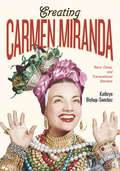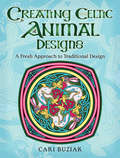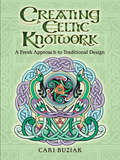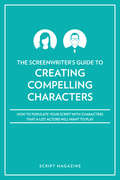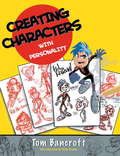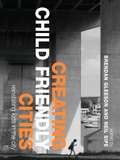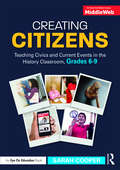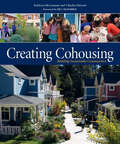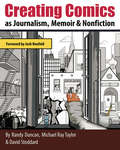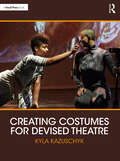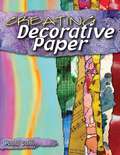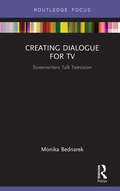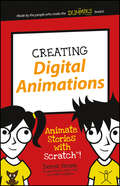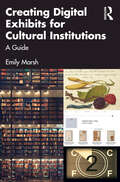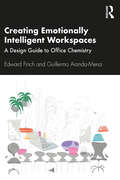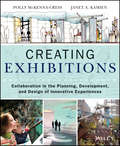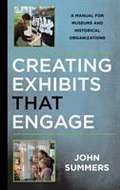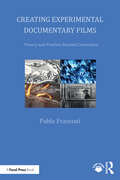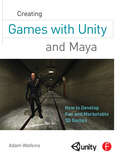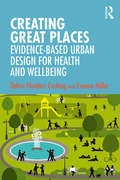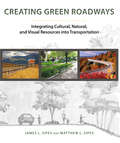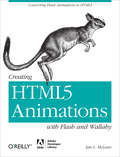- Table View
- List View
Creating Carmen Miranda: Race, Camp, and Transnational Stardom (Performing Latin American and Caribbean Identities)
by Kathryn Bishop-SanchezCarmen Miranda got knocked down and kept going. Filming an appearance on The Jimmy Durante Show on August 4, 1955, the "ambassadress of samba" suddenly took a knee during a dance number, clearly in distress. Durante covered without missing a beat, and Miranda was back on her feet in a matter of moments to continue with what she did best: performing. By the next morning, she was dead from heart failure at age 46.This final performance in many ways exemplified the power of Carmen Miranda. The actress, singer, and dancer pursued a relentless mission to demonstrate the provocative theatrical force of her cultural roots in Brazil. Armed with bare-midriff dresses, platform shoes, and her iconic fruit-basket headdresses, Miranda stole the show in films like That Night in Rio and The Gang's All Here. For American film audiences, her life was an example of the exoticism of a mysterious, sensual South America. For Brazilian and Latin American audiences, she was an icon. For the gay community, she became a work of art personified and a symbol of courage and charisma.In Creating Carmen Miranda, Kathryn Bishop-Sanchez takes the reader through the myriad methods Miranda consciously used to shape her performance of race, gender, and camp culture, all to further her journey down the road to becoming a legend.
Creating Carmen Miranda: Race, Camp, and Transnational Stardom (Performing Latin American and Caribbean Identities)
by Kathryn Bishop-SanchezCarmen Miranda got knocked down and kept going. Filming an appearance on The Jimmy Durante Show on August 4, 1955, the "ambassadress of samba" suddenly took a knee during a dance number, clearly in distress. Durante covered without missing a beat, and Miranda was back on her feet in a matter of moments to continue with what she did best: performing. By the next morning, she was dead from heart failure at age 46. This final performance in many ways exemplified the power of Carmen Miranda. The actress, singer, and dancer pursued a relentless mission to demonstrate the provocative theatrical force of her cultural roots in Brazil. Armed with bare-midriff dresses, platform shoes, and her iconic fruit-basket headdresses, Miranda stole the show in films like That Night in Rio and The Gang's All Here. For American film audiences, her life was an example of the exoticism of a mysterious, sensual South America. For Brazilian and Latin American audiences, she was an icon. For the gay community, she became a work of art personified and a symbol of courage and charisma. In Creating Carmen Miranda, Kathryn Bishop-Sanchez takes the reader through the myriad methods Miranda consciously used to shape her performance of race, gender, and camp culture, all to further her journey down the road to becoming a legend.
Creating Celtic Animal Designs: A Fresh Approach to Traditional Design
by Cari BuziakMany instruction books just teach how to duplicate designs without providing any clues for the next step — making your own! This unique guide features the highly effective Aon method, a technique for creating your own original designs rather than copying examples. It's easy to comprehend, with simple step-by-step instructions that focus on incorporating animal forms into Celtic patterns and designs.Creating Celtic Animal Designs builds on author Cari Buziak's experience teaching and writing about Celtic patterns and their creation, meaning, and history. Her nine in-depth examples encompass both traditional and contemporary renderings of animals — hounds, lions, hares, birds, and other creatures. Cari demonstrates the freehand drawing of Celtic knots and moves beyond the basics to show how to manipulate and develop stand-alone patterns into panels and combinations. Artists, designers, art instructors, tattoo artists, and anyone who appreciates Celtic designs will find this book a treasury of both instruction and inspiration.
Creating Celtic Knotwork: A Fresh Approach to Traditional Design (Dover Art Instruction)
by Cari BuziakWhether you're a complete beginner or have already attempted to learn the art of Celtic knotwork, this is the book for you! Artists at all levels will treasure this guide, which not only demonstrates how to duplicate patterns from a rich and varied gallery of examples but also how to take the next step to creating your own unique designs.This newly revised edition of Creating Celtic Knotwork features a wealth of added material and revisions. Author Cari Buziak draws upon her extensive teaching experience to present easy-to-understand, well-illustrated instructions that explain all the basic techniques of Celtic patterns as well as the art's meaning and history. In addition to spirals, mazes, and step patterns, the designs include dragons, hounds, and other animals as well as human forms. Exercises and tips encourage experimentation that will allow you to develop your own variations on traditional forms. Information on drawing tools, painting materials, transferring patterns, and other practical aspects will help you get started right away.
Creating Characters A-List Actors Want to Play
by Jeanne Bowerman Script Magazine EditorsThere's no better way to sell your script than to attract an A-List star to be a part of your film. But with thousands of scripts in circulation at all times, how can you make yours more appealing to Hollywood's most sought after performers?Creating Characters A-List Actors Want To Play is a collection of articles from Script Magazine that will guide you on your mission to create stand-out, memorable characters. Film industry experts provide advice based on the many scripts they've worked on and read throughout their careers: the good, the bad, and the ugly.These articles explore how to create memorable, developed characters who are relatable, nuanced, and engaging. Characters who have strong points of views, motivations, and inner conflicts. You will learn how film archetypes have morphed into tired stereotypes, and thus how to avoid the same fate for your own characters. You will learn how to employ personality quirks and the unexpected to elevate your characters beyond the confines of tropes. Articles explore the importance of raising the stakes, giving your characters a hard time, and making sure that the audience will empathize with them. You will learn how to utilize the whole cast of your script to show the layers of the protagonist, how to develop great villains, and why you need to take your character to the point of no return. Creating Characters A-List Actors Want To Play also covers writing dimensional female characters, how to utilize the 5 stages of grief and basic psychology, how to write intriguing character descriptions that appeal to actors, and various exercises to help you get to know your characters better.Contributors to this collection include Jeanne Veillette Bowerman (writer of the adaptation of the book Slavery by Another Name), Jerry Flattum (writer of Watertown, South Dakota, and Celestial Age), Heather Hale (writer of Absolute Killers and The Courage to Love), Marilyn Horowitz (professor and writing consultant), Brad Johnson (screenwriter and producer), Jacob Krueger (writer of The Matthew Shepard Story), Daniel Manus (founder of No Bull Script Consulting), Hayley McKenzie (writer of Papadopoulos & Sons, Chakara, and The Watcher Self), Drew Yanno (screenwriter and screenwriting professor), and Brett Wean (writer, actor, and improv instructor).If you're ready to make your characters dimensional enough to catch an Oscar winner's attention, get your copy of Creating Characters A-List Actors Want To Play today!
Creating Characters with Personality
by Glen Keane Tom BancroftFrom Snow White to Shrek, from Fred Flintstone to SpongeBob SquarePants, the design of a character conveys personality before a single word of dialogue is spoken. Designing Characters with Personality shows artists how to create a distinctive character, then place that character in context within a script, establish hierarchy, and maximize the impact of pose and expression. Practical exercises help readers put everything together to make their new characters sparkle. Lessons from the author, who designed the dragon Mushu (voiced by Eddie Murphy) in Disney's Mulan--plus big-name experts in film, TV, video games, and graphic novels--make a complex subject accessible to every artist.
Creating Child Friendly Cities: New Perspectives and Prospects
by Neil Sipe Brendan GleesonFirst Published in 2006. Routledge is an imprint of Taylor & Francis, an informa company.
Creating Citizens: Teaching Civics and Current Events in the History Classroom, Grades 6–9
by Sarah CooperEngage students in meaningful civic learning and encourage them to become active and informed citizens. With this essential book, co-published by Routledge and MiddleWeb, you will gain a variety of practical strategies for teaching civics and current events to your middle school students. Author and expert teacher Sarah Cooper takes you into her school and shares her classroom-tested methods and tools.Topics include: Fitting current events into an already-packed history curriculum Staying nonpartisan and fostering balanced discussions Helping students find their stake in the news Teaching civic literacy through primary sources, then and now Encouraging students to invest in analytical writing Fostering student ownership of our classrooms through discussion and debate Cultivating citizenship through empathy and community engagement Throughout the book, you’ll find student examples, handouts, and rubrics, so that you can easily implement the ideas in your own classroom. By getting your students to think critically about current events, you will help them become passionate writers, thinkers, and involved citizens.
Creating Cohousing
by Kathryn Mccamant Charles DurrettCohousing balances privacy and independence with the benefits of living in community. This completely revised and updated third edition of the "cohousing bible" invites readers into these sustainable neighborhoods, and provides practical tools for developing their own.
Creating Comics as Journalism, Memoir and Nonfiction
by Randy Duncan Michael Ray Taylor David StoddardThis book provides student journalists, artists, designers, creative writers and web producers with the tools and techniques they need to tell nonfiction stories visually and graphically. Weaving together history, theory, and practical advice, seasoned nonfiction comics professors and scholars Randy Duncan, Michael Ray Taylor and David Stoddard present a hands-on approach to teach readers from a range of backgrounds how to develop and create a graphic nonfiction story from start to finish. The book offers guidance on: -how to find stories and make use of appropriate facts and visuals; -nonfiction narrative techniques; -artist's tools and techniques; -print, digital, and multimedia production; -legal and ethical considerations. Interviews with well-known nonfiction comics creators and editors discuss best practices and offer readers inspiration to begin creating their own work, and exercises at the end of each chapter encourage students to hone their skills.
Creating Costumes for Devised Theatre
by Kyla KazuschykCreating Costumes for Devised Theatre combines perspectives from a variety of theatre practitioners to guide artists through the journey of creating costumes for devised work. Devised theatre can take a number of different forms, and it can be a challenge for the costume department to plan, organize, and assemble things for performers to wear while the entire shape of the piece is constantly changing. This book provides practical resources to guide the theatre artist through the journey of designing costumes as the characters are created. It addresses a wide range of questions, including how to adapt traditional methods of costume design to non-traditional practices, how to effectively collaborate with a team, and how to adapt costume technology practices to meet the needs of devising. Stories and photographs from performers, designers, technicians, directors, writers, educators, students, and activists working in the realm of devised theatre around the world are contextualized through the author's own involvement in unscripted, partially scripted, and otherwise dynamic drama, dance, and physical theatre to offer tangible solutions to streamline costume design and construction processes. This book is an invaluable guide for both experienced and novice costume designers, costume technicians, students, teachers, directors, managers, and theatre artists who exist in the spaces where all these roles overlap.
Creating Decorative Paper
by Paula GuhinPaint, print, layer, and scrape to produce vibrant, creative papers for scrapbooks, greeting cards, collages, gift wrap, book making, and decorating surfaces.
Creating Dialogue for TV: Screenwriters Talk Television (Routledge Studies in Media Theory and Practice)
by Monika BednarekAs entertaining as it is enlightening, Creating Dialogue for TV: Screenwriters Talk Television presents interviews with five Hollywood professionals who talk about all things related to dialogue – from naturalistic style to the building of characters to swearing and dialect. Screenwriters/showrunners David Mandel (Curb Your Enthusiasm, Veep), Jane Espenson (Buffy, Battlestar Galactica, Once Upon a Time), Robert Berens (Supernatural), Sheila Lawrence (Gilmore Girls, Ugly Betty, The Marvelous Mrs Maisel), and Doris Egan (Tru Calling, House, Reign) field a linguist’s inquiries about the craft of writing dialogue. This book is for anyone who has ever wondered what creative processes and attitudes lie behind the words they encounter when tuning into their favourite television show. It provides direct insights into Hollywood writers’ knowledge and opinions of how language is used in television narratives, and in doing so shows how language awareness, attitudes and the craft of using words are utilised to create popular TV series. The book will appeal to students and teachers in screenwriting, creative writing and linguistics as well as lay readers.
Creating Digital Animations
by Derek BreenThe easy way to start animating today! Creating Digital Animations is your ticket to learning animation! Learn how to animate your very own characters using Scratch--the free multimedia tool that lets you create interactive stories, games, and animations. Designed specifically for kids aged seven and up, this easy-to-follow, full-color guide introduces you to important game design concepts through three simple projects. Step-by-step instructions walk you through the four major phases of animation design, showing you how to turn your idea into a real animation with sound effects and more! You'll work just like the pros as you sketch out your main idea, add your own details, and develop a complete, workable character from scratch. If you're curious about coding, animation is the perfect place to start exploring. The Scratch platform doesn't require an actual programming language, but it gets you used to thinking like a programmer while you develop your very own animation. Short on rules but big on fun, this book is your friendly animation coach to get you started on the right foot. Use stick figures to design your characters' 'bones' Flesh out your design and animate movements Create scenes and background locations Add sound to take your animation to the next level Animation is fun! Building your own characters is exciting! And putting the finishing touches on your animation project shows you just how much you can learn while you play. Coding is a valuable skill that will serve you throughout school and beyond, and this book teaches you the basics in a way that leaves you hungry for more. Where will you take your new animation skills next? Creating Digital Animations takes you on the first steps of your journey to wherever you want to go!
Creating Digital Exhibits for Cultural Institutions: A Guide
by Emily MarshCreating Digital Exhibits for Cultural Institutions will show you how to create digital exhibits and experiences for your users that will be informative, accessible and engaging. Illustrated with real-world examples of digital exhibits from a range of GLAMs, the book addresses the many analytical aspects and practical considerations involved in the creation of such exhibits. It will support you as you go about: analyzing content to find hidden themes, applying principles from the museum exhibit literature, placing your content within internal and external information ecosystems, selecting exhibit software, and finding ways to recognize and use your own creativity. Demonstrating that an exhibit provides a useful and creative connecting point where your content, your organization, and your audience can meet, the book also demonstrates that such exhibits can provide a way to revisit difficult and painful material in a way that includes frank and enlightened analyses of issues such as racism, colonialism, sexism, class, and LGBTQI+ issues. Creating Digital Exhibits for Cultural Institutions is an essential resource for librarians, archivists, and other cultural heritage professionals who want to promote their institution’s digital content to the widest possible audience. Academics and students working in the fields of library and information science, museum studies and digital humanities will also find much to interest them within the pages of this book.
Creating Distinctions in Dutch Genre Painting: Repetition and Invention (Visual and Material Culture, 1300-1700)
by Angela HoIn the mid- to late seventeenth century, a number of Dutch painters created a new type of refined genre painting that was much admired by elite collectors. In this book, Angela Ho uses the examples of Gerrit Dou, Gerard ter Borch, and Frans van Mieris to show how this group of artists made creative use of repetition-such as crafting virtuosic, self-referential compositions around signature motifs, or engaging esteemed predecessors in a competitive dialogue through emulation-to project a distinctive artistic personality. The resulting paintings enabled purchasers and viewers to exercise their connoisseurial eye and claim membership in an exclusive circle of sophisticated enthusiasts-making creative repetition a successful strategy for both artists and viewers.|Angela Ho shows how Dutch painters in the mid- to late 17th century used repetition to project a distinctive artistic personality.
Creating Emotionally Intelligent Workspaces: A Design Guide to Office Chemistry
by Edward Finch Guillermo Aranda-MenaEmotions in the workplace have until recently been seen simply as a distraction. We often think of work as rational, logical and non-emotional. But organisations are waking up to the key role of emotions and affect at work. Emotions influence how we make decisions, how we relate with one another and how we make sense of our surroundings. Whilst organisations are slowly embracing the pivotal role of emotions, designers and managers of workplaces have been struggling to keep up. New insights from hard sciences such as neuropsychology are presenting a radically different interpretation of emotions. Yet workplace designers and facilities managers still rely on measuring non-specific states such as satisfaction and stress. In this book we attempt to capture modern-day interpretations of emotion, looking at emotion in terms of transactions and processes rather than simple cause and effect. We entertain the idea of an ‘emotionally intelligent building’ as an alternative to the much-hyped intelligent building. The assertion is that we should create environments that are emotionally intelligent. Rather than focusing on the aptitudes or shortcomings of individuals at work, we should place closer attention on the office environment. It’s not that we are emotionally disabled – it’s the environment that disables us! The ability of you and me to interpret, control and express emotions may not simply be a result of our own make-up. A radically different outlook considers how our workspace and workplace debilitates or enables our emotional understanding. In the modern workplace there are many innovations that can undermine our emotional intelligence, such poorly implemented hot-desking or lean environments. Contrariwise there are key innovations such as Activity Based Working (ABW) that have the potential to enhance our emotional state. Through a series of unique case studies from around the world, we investigate key concepts that can be used by designers and facilities managers alike. No longer should designers be asked to incorporate emotional elements as intangible un-costed ‘add-ons’. This book provides a shot in the arm for workplace design professionals, pointing to a new way of thinking based on the emotional intelligence of the workplace.
Creating Exhibitions
by Polly Mckenna-Cress Janet Kamien"This is a must-read for the nervous novice as well as the world-weary veteran. The book guides you through every aspect of exhibit making, from concept to completion. The say the devil is in the details, but so is the divine. This carefully crafted tome helps you to avoid the pitfalls in the process, so you can have fun creating something inspirational. It perfectly supports the dictum--if you don't have fun making an exhibit, the visitor won't have fun using it." --Jeff Hoke, Senior Exhibit Designer at Monterey Bay Aquarium and Author of The Museum of Lost WonderStructured around the key phases of the exhibition design process, this guide offers complete coverage of the tools and processes required to develop successful exhibitions. Intended to appeal to the broad range of stakeholders in any exhibition design process, the book offers this critical information in the context of a collaborative process intended to drive innovation for exhibition design. It is indispensable reading for students and professionals in exhibit design, graphic design, environmental design, industrial design, interior design, and architecture.
Creating Exhibits That Engage: A Manual For Museums And Historical Organizations (American Association For State And Local History)
by John SummersCreating Exhibits that Engage: A Manual for Museums and Historical Organizations is a concise, useful guide to developing effective and memorable museum exhibits. The book is full of information, guidelines, tips, and concrete examples drawn from the author’s years of experience as a curator and exhibit developer in the United States and Canada. Is this your first exhibit project? You will find step-by-step instructions, useful advice and plenty of examples. Are you a small museum or local historical society looking to improve your exhibits? <p><p> This book will take you through how to define your audience, develop a big idea, write the text, manage the budget, design the graphics, arrange the gallery, select artifacts, and fabricate, install and evaluate the exhibit. Are you a museum studies student wanting to learn about the theory and practice of exhibit development? This book combines both and includes references to works by noted authors in the field. Written in a clear and accessible style, Creating Exhibits that Engage offers checklists of key points at the end of each chapter, a glossary of specialized terms, and photographs, drawings and charts illustrating key concepts and techniques.
Creating Experimental Documentary Films: Theory and Practice Beyond Convention
by Pablo FrasconiThis book explores the continued development and practice of experimental documentary film making with evolving trends in still photography, visual arts, journalism, installation art, docudrama, interactive media, music, poetry, and creative nonfiction. Through examples, observations, analyses, and exercises, readers will gain an understanding of the traditional principles of documentary and simultaneously challenge those conventions.While exploring the responsibilities of a documentary director to be fair and objective, the book weaves through arguments around truth and propaganda and offers practical lessons about how to create hybrid forms of documentary films. Written by a documentary filmmaker with decades of experience, the text provides a comprehensive overview of how documentary narratives are written and created in the research, pre-production, production and post-production phases. New, inclusive audiences and methods of distribution, interactivity, and immersion are also introduced as part of the changing landscape of the documentary genre.This book is designed for students who are approaching documentary for the first time as well as documentary filmmakers who are searching for new approaches, new subject matter, and languages of cinematic expression.
Creating Games with Unity and Maya: How to Develop Fun and Marketable 3D Games
by Adam WatkinsUnity brings you ever closer to the "author once, deploy anywhere" dream. With its multiplatform capabilities, you can target desktop, web, mobile devices, and consoles using a single development engine. Little wonder that Unity has quickly become the #1 game engine out there. Mastering Unity is absolutely essential in an increasingly competitive games market where agility is expected, yet until now practical tutorials were nearly impossible to find. Creating Games with Unity and Maya gives you with an end-to-end solution for Unity game development with Maya. Written by a twelve-year veteran of the 3D animation and games industry and professor of 3D animation, this book takes you step-by-step through the process of developing an entire game from scratch-including coding, art, production, and deployment. This accessible guide provides a "non-programmer" entry point to the world of game creation. Aspiring developers with little or no coding experience will learn character development in Maya, scripts, GUI interface, and first- and third-person interactions.
Creating Great Places: Evidence-based Urban Design for Health and Wellbeing
by Debra Flanders Cushing Evonne MillerThis book provides a bold vision and roadmap for creating great places. Imagining and designing urban environments where all people thrive is an extraordinary task, and in this compelling narrative, Cushing and Miller remind us that theory is a powerful starting point. Drawing on international research, illustrated case studies, personal experiences, as well as fascinating examples from history and pop culture, this practical book provides the reader with inspiration, guidance and tools. The first section outlines six critical theories for contemporary urban design - affordance, prospect-refuge, personal space, sense of place/genius loci, place attachment, and biophilic design. The second section, using their innovative ‘theory-storming’ process, demonstrates how designers can create great places that are inclusive, sustainable, and salutogenic. Creating Great Places is an insightful, compelling, and evidence-based resource for readers who want to design urban environments that inspire, excite, and positively transform people’s lives.
Creating Green Roadways: Integrating Cultural, Natural, and Visual Resources into Transportation
by James L. Sipes Matthew L. SipesRoads and parking lots in the United States cover more ground than the entire state of Georgia. And while proponents of sustainable transit often focus on getting people off the roads, they will remain at the heart of our transportation systems for the foreseeable future. In Creating Green Roadways, James and Matthew Sipes demonstrate that roads don't have to be the enemy of sustainability: they can be designed to minimally impact the environment while improving quality of life. The authors examine traditional, utilitarian methods of transportation planning that have resulted in a host of negative impacts: from urban sprawl and congestion to loss of community identity and excess air and water pollution. They offer a better approach--one that blends form and function. Creating Green Roadways covers topics including transportation policy, the basics of green road design, including an examination of complete streets, public involvement, road ecology, and the economics of sustainable roads. Case studies from metropolitan, suburban, and rural transportation projects around the country, along with numerous photographs, illustrate what makes a project successful. The need for this information has never been greater, as more than thirty percent of America's major roads are in poor or mediocre condition, more than a quarter of the nation's bridges are structurally deficient or functionally obsolete, and congestion in communities of all sizes has never been worse. Creating Green Roadways offers a practical strategy for rethinking how we design, plan, and maintain our transportation infrastructure.
Creating HDR Photos: The Complete Guide to High Dynamic Range Photography
by Harold DavisSince the days of the first photographs, artists have used various techniques to extend the range of lights and darks in their photos. Photographic masters such as Ansel Adams and Edward Weston spent countless hours burning and dodging their prints to create images with extended dynamic range. With the advent of digital photography, new horizons in extending dynamic range are possible. HDR techniques now make it easy to extend the dynamic range of an image well beyond the capability of the human eye.In Creating HDR Photos, bestselling author Harold Davis covers the complete HDR workflow, from choosing the subjects that work best for HDR through processing RAW files to unlock the dynamic power of HDR. You'll learn how to photograph multiple exposures and blend them into a single HDR image using various software programs. Best of all, you will find out how to control the style of your HDR images, from subtle to hyper-real, using a range of photographic and post-processing techniques. Packed with stunning image examples, Creating HDR Photos brings this essential digital technique within every photographer's grasp.
Creating HTML5 Animations with Flash and Wallaby: Converting Flash Animations to HTML5 (Oreilly And Associate Ser.)
by Ian L. McLeanCreating standards-compliant animations for the Web just got a lot easier. With this concise guide, you’ll learn how to convert Flash animations into HTML5, using Wallaby—the experimental tool from Adobe. Wallaby makes Flash content available for devices that don't support Flash runtimes, including the iPhone and iPad.Developing HTML5 animations is time-consuming with all the coding required. This book shows you how to create compelling content for HTML5 environments with relative ease, whether you know Flash or not. After a quick introduction to simple animation building with Flash, you'll learn how Wallaby helps you convert those animations into HTML5 code.Learn how to create a simple Flash animation, using Flash Professional CS5Become familiar with the Flash Library, Stage drawing canvas, and animation TimelineTake the right approach to building a complex Flash animation for HTML5Get performance tips to optimize animations for desktops and mobile devicesUse simple JavaScript and CSS code to place the Wallaby animation in a web pageAdd interactivity to your HTML5 animation with jQuery
